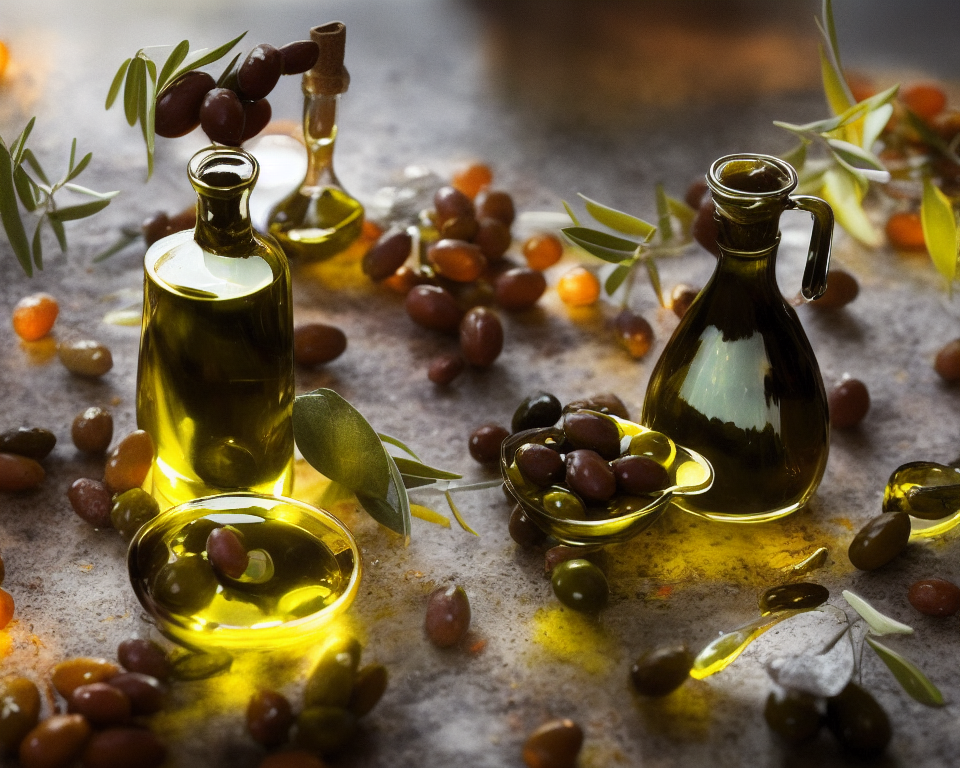
**Beware of Fake EVOO: What is a Good Acidity Level for Extra Virgin Olive Oil?**
Share
The quality of extra virgin olive oil can be objectively determined by evaluating the quantity and composition of fatty acids, tocopherols, and vitamins. Other elements, such as acidity, also play a significant role in determining the quality of a given product.
**Polyphenols**
Polyphenols are antioxidants that give olive oil its rich, deep color and many health benefits. They also create a sensory experience for the palate by adding an unusual savory flavor to otherwise bland vegetable-based dishes or a topping that can be enjoyed as part of a meal if used wisely! A recent study has revealed more about how polyphenols interact with our bodies: they show promise in fighting cancer because these compounds disrupt cell growth at different stages depending on their chemical composition (i.e., some stop cells from reproducing while others may block energy production). So, next time you're cooking dinner, think beyond those old, boring tubs of margarine—try using extra virgin olive oil instead!
**Oil Peroxides**
You may have already heard the term "oxidative aging," but do you know what it means? Oxidative alteration occurs when peroxide levels increase, leading to an aged appearance on your skin. Peroxidation occurs naturally with UV exposure or during cooking of the oil; however, these processes can be accelerated by overcooking food (such as frying), which generates free radicals that damage our body’s cells through inflammatory response proteins called prostaglandins—this leads to a vicious cycle where more toxins unnecessarily enter circulation because they are produced faster than we can eliminate them!
**Acidity Limit for Extra Virgin Olive Oil**
The acidity limit for extra virgin olive oil is 0.8%, but in a quality product, values are significantly lower (0-0.3%), with some as low as 20 or 30 milliliters per kilogram (mL/kg). This means that you may also find oils with more than 2% and up to 3% acidity. However, if there is something off about its taste, there is a high chance that the oil has exceeded this amount due to unwanted bacterial growth.
**Research on Preserving the Acidity of Extra Virgin Olive Oil**
With increased exposure to oxygen, even just through the process of opening and closing a bottle, there is a greater chance of oxidative damage (rancidity). Even small amounts of oxidation make a difference in the flavor and shelf life of your oils. The best thing is to keep your oils tightly sealed in a cool, dark environment. It’s also recommended to date them once opened so you know how long they have been exposed to air, although this isn’t always possible.
A 2007 study by the Department of Food Science and Technology at the University of California found that acidity levels can be measured accurately, making it possible to monitor their progress as they oxidize. Researchers used nuclear magnetic resonance (NMR) spectroscopy to determine how many molecules were present and found a direct correlation between acidity level and oil aging. Not only did they discover that this method could easily measure an oil’s acidity, but they also found that it could be used to track how quickly an oil is degrading. The study provides new insights into how and why oils age, and what causes flavor degradation over time. It directly correlates an oil’s acidity with its oxidative state, something that had never been done before. Previous studies on aging were limited to sensory analysis or oxidation by-products. In this study, acidity concentration was directly measured and found to increase over time in direct proportion to other markers of oil degradation.
In olive oil, its freshness is determined by hydroxytyrosol and tyrosol [the good antioxidants], which should not be present if the oil is rancid. "It has long been known that the quality of virgin olive oils can be determined based on their content of these two compounds," says research director Nuria Larrañaga of the UC Davis Olive Center, who led the study. The new technique determines how much antioxidant remains after exposure to light and heat (or storage conditions) by measuring the amount of two degradation products. How do you know if your oils are becoming old or rancid? The study found that within 48 hours, there is a 30 percent loss of volatiles in extra virgin olive oil. After a month, there is a 40% loss, and after three months, nearly a 60% loss.
**Polyphenols**
Polyphenols are antioxidants that give olive oil its rich, deep color and many health benefits. They also create a sensory experience for the palate by adding an unusual savory flavor to otherwise bland vegetable-based dishes or a topping that can be enjoyed as part of a meal if used wisely! A recent study has revealed more about how polyphenols interact with our bodies: they show promise in fighting cancer because these compounds disrupt cell growth at different stages depending on their chemical composition (i.e., some stop cells from reproducing while others may block energy production). So, next time you're cooking dinner, think beyond those old, boring tubs of margarine—try using extra virgin olive oil instead!
**Oil Peroxides**
You may have already heard the term "oxidative aging," but do you know what it means? Oxidative alteration occurs when peroxide levels increase, leading to an aged appearance on your skin. Peroxidation occurs naturally with UV exposure or during cooking of the oil; however, these processes can be accelerated by overcooking food (such as frying), which generates free radicals that damage our body’s cells through inflammatory response proteins called prostaglandins—this leads to a vicious cycle where more toxins unnecessarily enter circulation because they are produced faster than we can eliminate them!
**Acidity Limit for Extra Virgin Olive Oil**
The acidity limit for extra virgin olive oil is 0.8%, but in a quality product, values are significantly lower (0-0.3%), with some as low as 20 or 30 milliliters per kilogram (mL/kg). This means that you may also find oils with more than 2% and up to 3% acidity. However, if there is something off about its taste, there is a high chance that the oil has exceeded this amount due to unwanted bacterial growth.
**Research on Preserving the Acidity of Extra Virgin Olive Oil**
With increased exposure to oxygen, even just through the process of opening and closing a bottle, there is a greater chance of oxidative damage (rancidity). Even small amounts of oxidation make a difference in the flavor and shelf life of your oils. The best thing is to keep your oils tightly sealed in a cool, dark environment. It’s also recommended to date them once opened so you know how long they have been exposed to air, although this isn’t always possible.
A 2007 study by the Department of Food Science and Technology at the University of California found that acidity levels can be measured accurately, making it possible to monitor their progress as they oxidize. Researchers used nuclear magnetic resonance (NMR) spectroscopy to determine how many molecules were present and found a direct correlation between acidity level and oil aging. Not only did they discover that this method could easily measure an oil’s acidity, but they also found that it could be used to track how quickly an oil is degrading. The study provides new insights into how and why oils age, and what causes flavor degradation over time. It directly correlates an oil’s acidity with its oxidative state, something that had never been done before. Previous studies on aging were limited to sensory analysis or oxidation by-products. In this study, acidity concentration was directly measured and found to increase over time in direct proportion to other markers of oil degradation.
In olive oil, its freshness is determined by hydroxytyrosol and tyrosol [the good antioxidants], which should not be present if the oil is rancid. "It has long been known that the quality of virgin olive oils can be determined based on their content of these two compounds," says research director Nuria Larrañaga of the UC Davis Olive Center, who led the study. The new technique determines how much antioxidant remains after exposure to light and heat (or storage conditions) by measuring the amount of two degradation products. How do you know if your oils are becoming old or rancid? The study found that within 48 hours, there is a 30 percent loss of volatiles in extra virgin olive oil. After a month, there is a 40% loss, and after three months, nearly a 60% loss.

